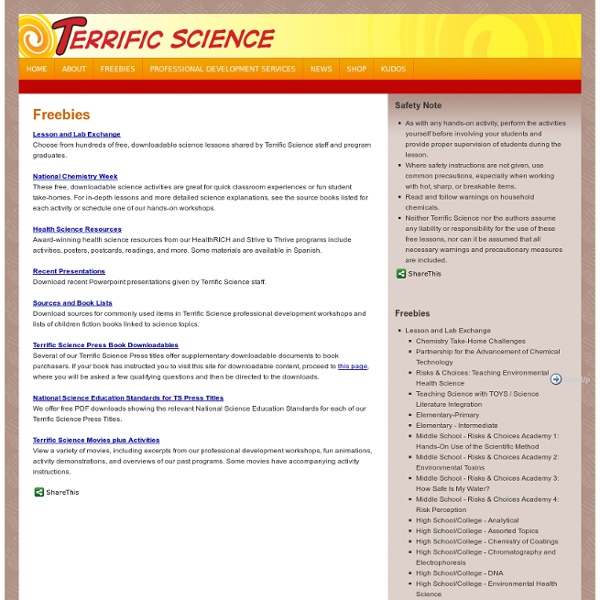



Science Matters Yah, I know some of us are winding down from schooling for the summer months, but I can’t help but stay on the lookout for resources I know I’m going to be needing again all too soon. I’ve come across some interesting science things of late that I want to check out – perhaps you, too, can find something useful. For your perusal: Free Online Textbooks and Curriculum Chemistry Packets: 13 units of chemistry; also has links to YouTube chemistry videos Classic Science Life: free life science e-textbook to download; either download by chapter (there are 36) or by unit (9 units); online courses also offered MS Nucleus: free science curriculum, K – 6 and some secondary Science Interactives and Videos Annenberg Learner : animations on a number of topics, including volcanos, DNA, the rock cycle and others; also has interactive on subjects other then science wickED: animations about the earth, including plate tectonics, the rock cycle Bytesize Science: chemistry videos ilabcentral: virtual lab
K-12 Science Welcome to SERC's portal for K-12 Educators. We've scoured dozens of educational project websites hosted by SERC to find the activities and resources of highest interest to K-12 educators. On this site, there are hundreds of classroom activities organized by grade level and topic as well as guidance on effective teaching. Search for Activities Here, you will find hundreds of lessons, activities, lab investigations, and field trip ideas on a wide range of topics to use in class. Interested in how the Next Generation Science Standards were informed? Resources for AP/IB/Honors High School Teachers On this page: Finding Lessons for Teaching | Finding Resources for Teaching Teaching with Maps On this page: Example Activities | Mapping Activity Collections | Resources from the National Association of Geoscience Teachers Collections of Lessons Improve Teaching and Learning How Students Learn On this page: Engagement, Learning, and Motivation | Teaching Controversial Topics Teaching Strategies
MAKE HOMEMADE SCIENCE TOYS AND PROJECTS NSDL.org - National Science Digital Library Universities with the Best Free Online Courses -- Education-Port Free online courses are offered by real schools. Learn which courses are available, what topics they cover and which ones lead to real college credit. Online Courses for Credit All of the schools listed below are well-known universities with a variety of free online course offerings. These classes are typically offered as part of an OpenCourseWare (OCW) project. Students who would like access to flexible online learning that can be used to earn college credit might want to consider Education Portal's courses on such areas as business, math, science, foreign languages, the social sciences and humanities. Business 103: Introductory Business Law - Survey the history of American law and the legal system before exploring the ins and outs of contract law, property law, labor law, sales and torts. Free Online Non-Credited Courses Carnegie Mellon University Carnegie Mellon University offers non-credit courses and materials through its free courseware program, the Open Learning Initiative.
Environmental Education Lesson Plans Skip to main navigation The lesson plans and accompanying activity sheets provided here were developed by DEC environmental educators. They have proven to be successful at environmental education centers, natural areas, and visits to classrooms These education tools bring young people in touch with the natural world and build their understanding of environmental issues. The lessons, which are divided into topic themes, are grouped by grade level: preK-3, 3-6 and 6-12. The links below lead to descriptions of the downloadable lessons and student activity sheets. Grades PreK- 3 Lesson Plans - lessons and activity sheets on insects, mammals, reptiles,wildlife, and waterGrades 3 - 6 Lesson Plans - lessons and activity sheets on insects, mammals, reptiles, wildlife, recycling, conservation, and waterGrades 6 - 12 Lesson Plans - lessons on mammals, wildlife, recycling, conservation, and water topics
Space Time Travel – Relativity Visualized 5 Really Weird Things About Water Water, good ol' H2O, seems like a pretty simple substance to you and me. But in reality, water - the foundation of life and most common of liquid - is really weird and scientists actually don't completely understand how water works. Here are 5 really weird things about water: 1. Take two pails of water; fill one with hot water and the other one with cold water, and put them in the freezer. In 1963, a Tanzanian high-school student named Erasto B. Thankfully, Mpemba didn't back down - he convinced a physics professor to conduct an experiment which eventually confirmed his observations: in certain conditions, hot water indeed freezes before cold water*. Actually, Mpemba was in good company. But how do scientists explain this strange phenomenon? 2. Everybody knows that when you cool water to 0 °C (32 °F) it forms ice ... except that in some cases it doesn't! Scientist know a lot about supercooling: it turns out that ice crystals need nucleation points to start forming. 3. 4. 5. [YouTube clip]